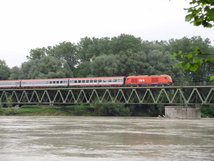Border: Austria-Germany
Date(s) of establishment: 1871Length of border: 784 km
Regions concerned: Germany – Baden-Württemberg, Bayern (Bavaria); Austria – Vorarlberg, Tyrol, Salzburg and Upper Austria
European programme(s):
- Interreg IV A "Bayern – Österreich"
Website of the programme
The programme on the Inforegio website - Interreg IV A "Alpenrhein – Bodensee – Hochrhein"
The programme on the Inforegio website
Established in 1871, the border between Germany and Austria is 784 km in length and is therefore Germany’s longest border. This delineation concerns two German Länder situated in the south of the country (Baden-Württemberg and Bavaria) and four provinces in the north-west of Austria (Voralberg, Tyrol, Salzburg and Upper Austria).
Mainly consisting of Alpine mountain ranges at its centre, the border begins in the north-west at Lake Constance, which separates Baden-Württemberg and Austria, before moving east up to the tripoint formed by the German-Czech and Czech-Austrian borders in the Bohemian Forest.
History
In 1363, the independence of the Duchy of Tyrol gave birth to the first Austro-German border. In 1805, the border demarcation underwent some changes including the acquisition of the Salzburg region by the Habsburgs. The founding of the Republic of Austria in 1918 stabilized the border before it disappeared with the annexation of Austria by Germany in 1938. At the end of the Second World War, the border was restored and has experienced no changes since.
Cross-border cooperation
Germany and Austria share the same official language, German, which facilitates the development of cross-border cooperation.
The Interreg cooperation programmes concern Bavaria and Baden-Württemberg, and North-West Austria and the westernmost part of Austria.
The objective of the first cross-border programme "Bayern - Österreich" is to promote the sustainable development and economic competitiveness of the region. This cross-border area has a GDP growth rate several times higher than the average of the European Union. However, the disparities between urban and rural areas continue to grow. The programme aims to support entrepreneurship and innovative initiatives to further develop the cross-border labour market and improve the attractiveness of the region.
The second cross-border programme "Alpenrhein - Bodensee - Hochrhein" is trinational and covers a smaller border area compared to the Germany-Austria cross-border programme. It also concerns a highly favoured area. The region therefore intends to use its economic potential to be at the forefront of innovation and improve its competitiveness. In order to achieve this, the programme promoted an advanced networking drive and labour markets in close cooperation.
Many organisations exist on this border such as the Arge Alp Working Community, or the Internationale Bodenseekonferenz (International Conference of Lake Constance) and the following Euroregions: Bayrischer Wald-Böhmerwald-Sumava; Inn Salzach; Salzburg-Berchtesgadener Land-Traunstein; Inntal; Zugspitze Wetterstein Karwendel; Via Salina; and Bodensee, symbolising a high degree of cooperation at multiple levels.
Territory projects and institutional bodies for cooperation
Cross-border cooperation at the regional level
Arge AlpCommunauté de travail Alpe-Adria
Euregio Inntal


